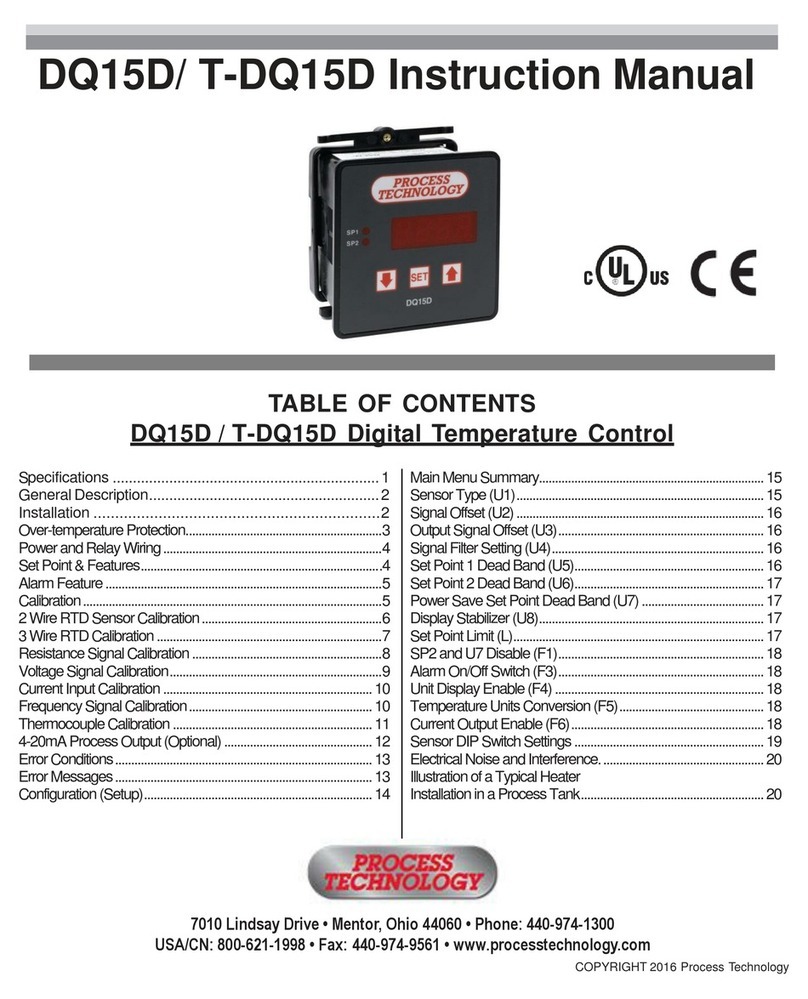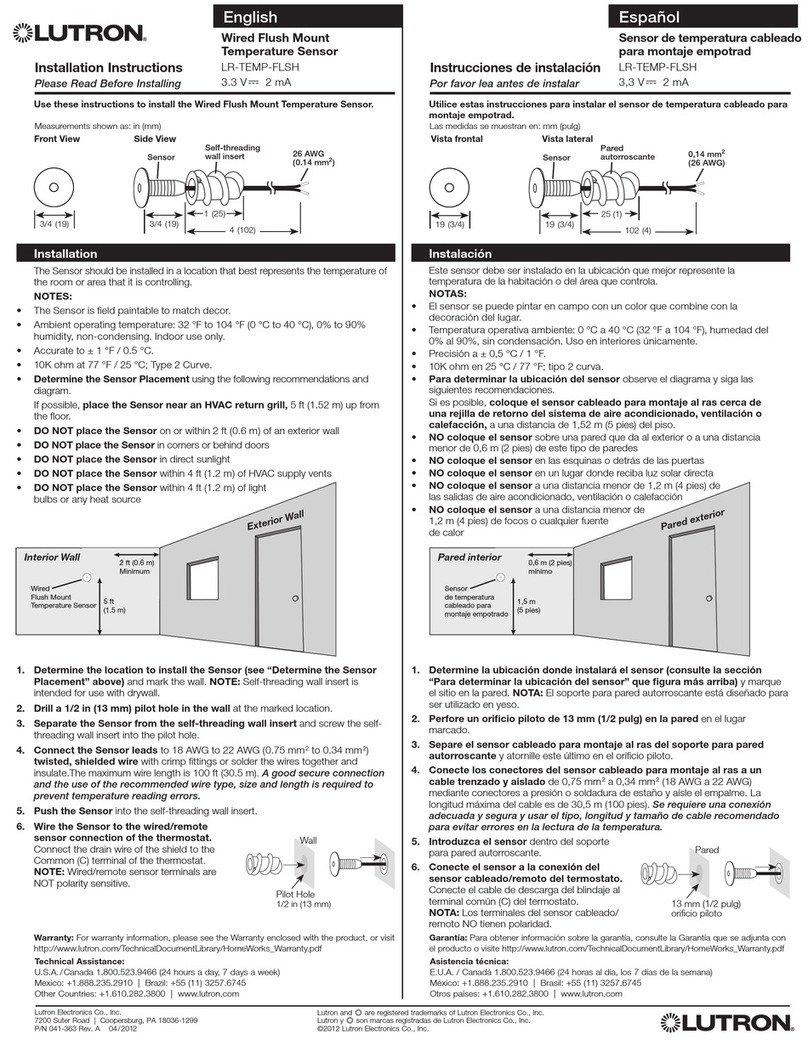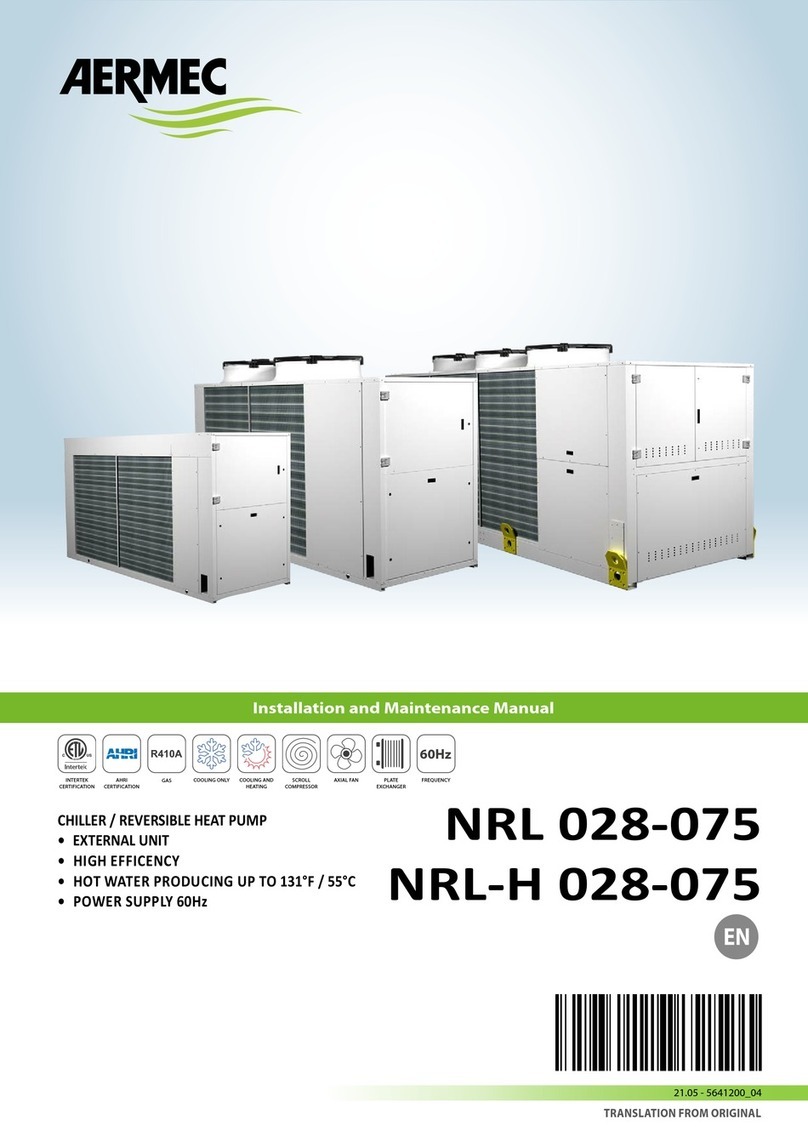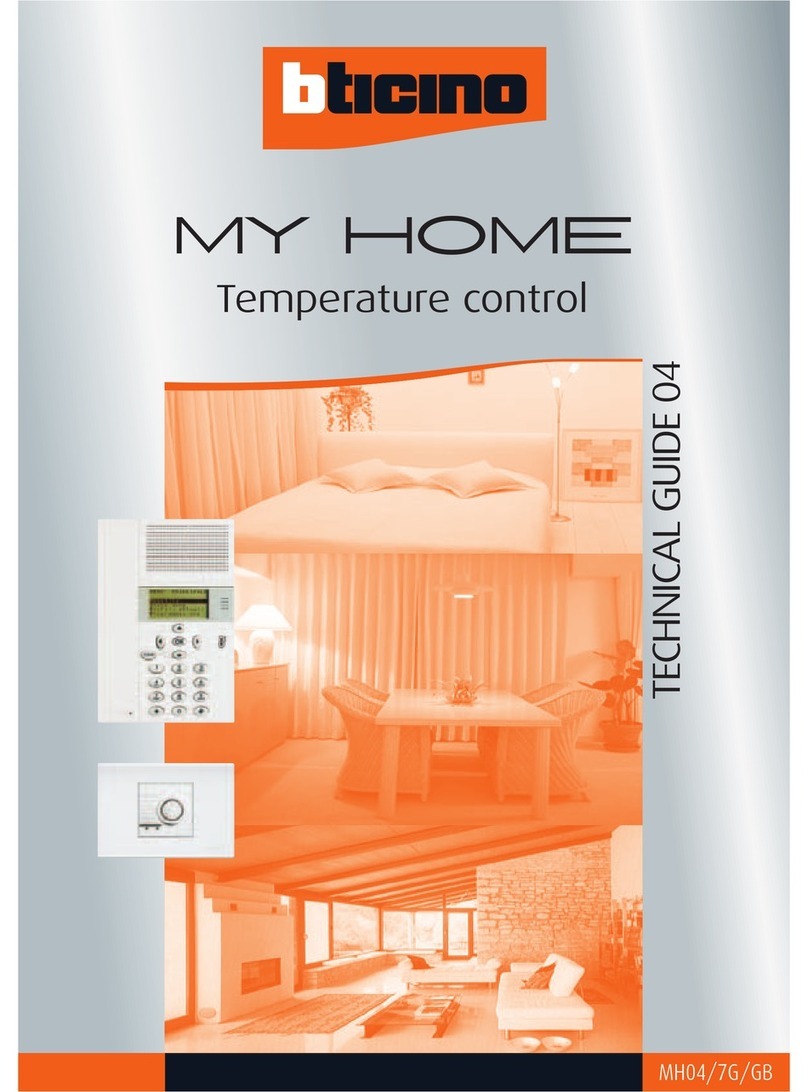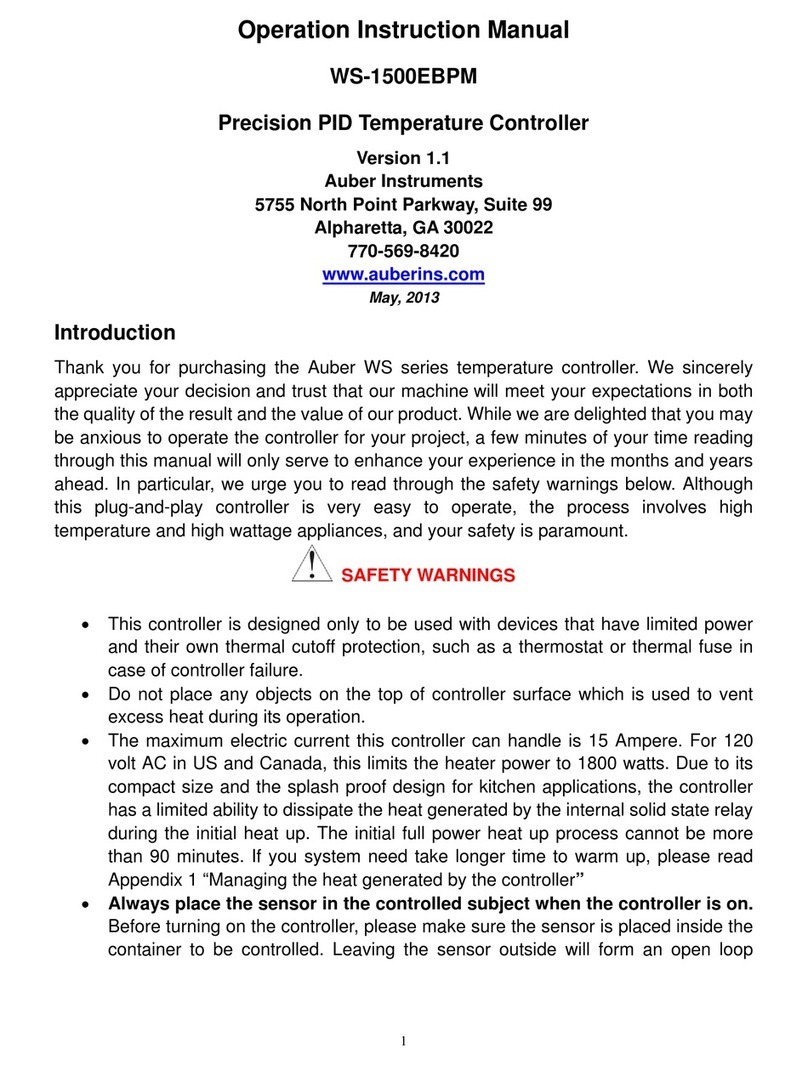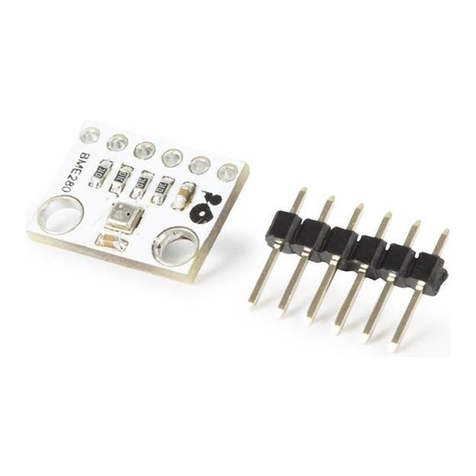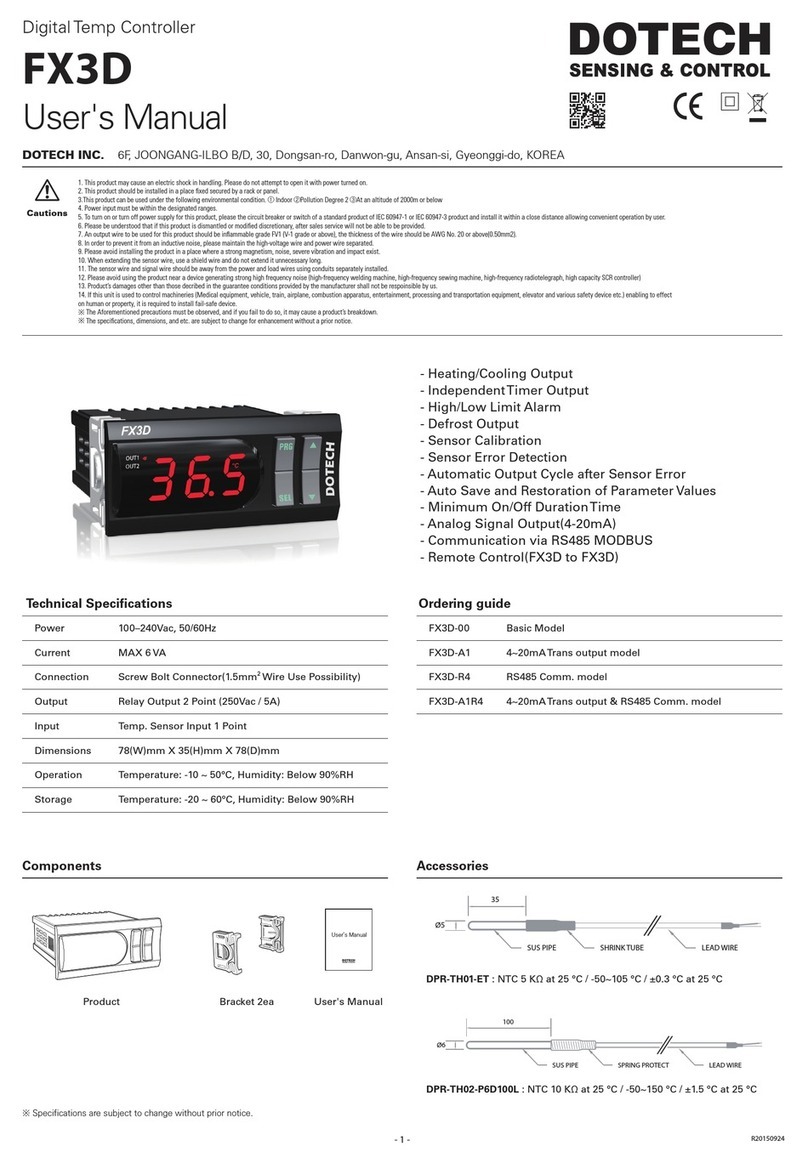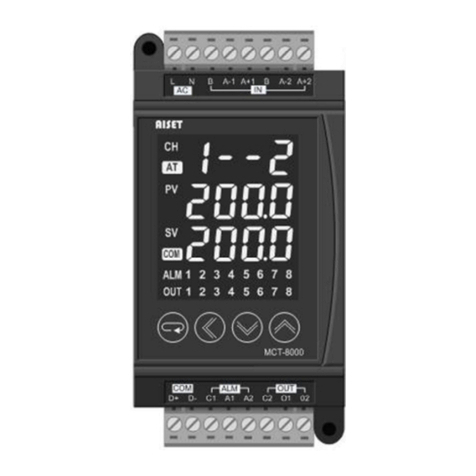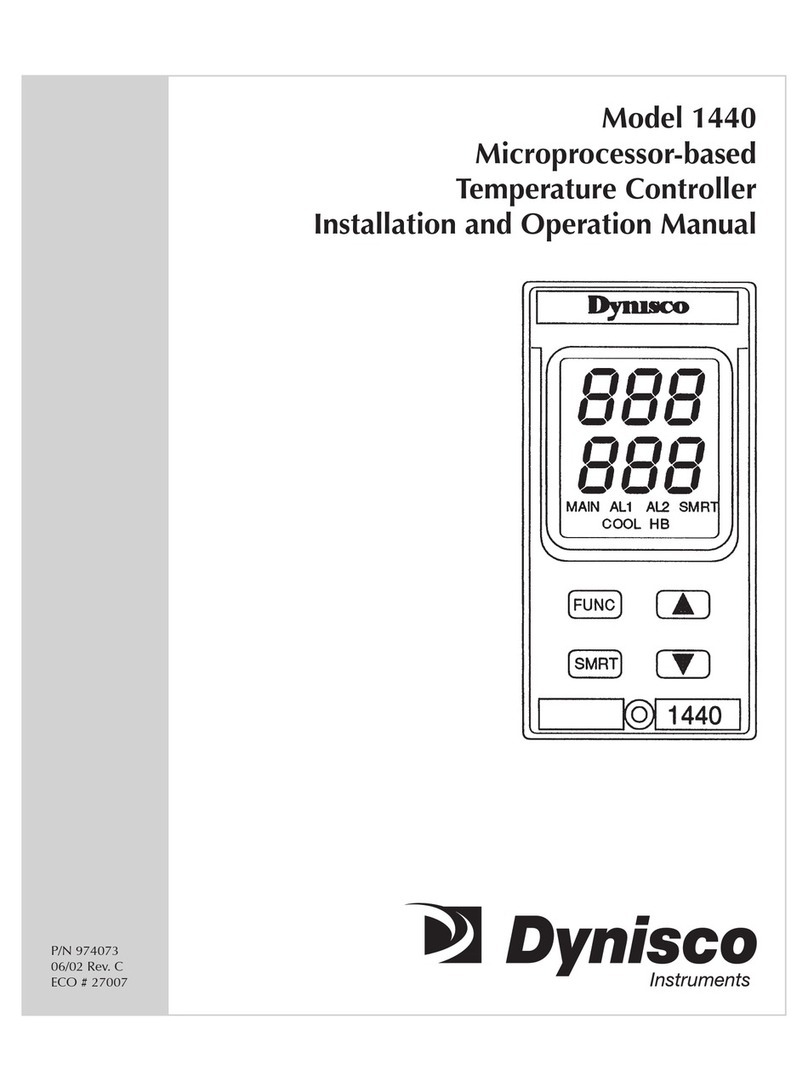Process Technology DE20 User manual

DE20 Instruction Manual
TABLE OF CONTENTS
DE20 Digital Temperature Control
7010 Lindsay Drive • Mentor, Ohio 44060 • Phone: 440-974-1300
USA/CN: 800-621-1998 • Fax: 440-974-9561 • www.process-technology.com
Specifications....................................................................1
GeneralDescription.........................................................2
InstallationProcedure.....................................................2
OvertemperatureProtection...........................................3
SetPoint&Features.........................................................4
AlarmFeature.....................................................................4
ErrorConditions................................................................4
ErrorMessages.................................................................4
PowerandRelayWiring....................................................5
2WireRTDSensorCalibration.......................................6
ResistanceSignalCalibration.......................................7
3WireRTDCalibration..................................................7
ThermocoupleCalibration.............................................8
VoltageSignalCalibration..............................................8
CurrentInputCalibration.................................................9
FrequencySignalCalibration.....................................10
Configuration(Setup)....................................................10
MainMenuSummary.....................................................10
SensorType (U1).............................................................11
SignalOffset(U2)...........................................................11
SignalFilterSetting(U4)..................................................11
Set Point Dead Band (U5) .........................................12
DisplayStabilizer(U8)...................................................12
SetPointLimit(L)..........................................................12
HeatingorCoolingSwitch(F2).....................................12
AlarmOn/OffSwitch(F3)..............................................13
UnitDisplayEnable(F4)..................................................13
TemperatureUnitsConversion(F5)............................13
SensorDIPSwitch Settings........................................13
ElectricalNoiseandInterference.................................13
Illustration of a Typical Heater Installation in a
ProcessTank...................................................................14
M-33-01-02 02/17/11

-14-
flame ignition systems or electrostatic precipitators are in the vicinity of the control.A more common source of
interference occurs when the control is switching inductive loads such as contactor coils, solenoids or
motors. The collapse of the magnetic field when loads such as these are switched off can create an electrical
“spike” that can cause a malfunction of the microprocessor used in the control. Even if the control doing the
switching is unaffected, a nearby control may be affected. To eliminate or minimize this problem, transient
suppressors or “snubbers” can be employed across the inductive load.
Illustration of a Typical Heater Installation in a Process Tank
CONSULT INSTALLATIONANDMAINTENANCE INFORMATION FORSPECIFIC INSTRUCTIONS
M-33-01-02 02/17/11
M-33-01-02 02/17/11
2 wire- 1000 ohm RTD TCR (alpha),
0.00385 ohm/ohm/°C
RTD Self Heating Coefficient:
5° C/w in 0.2 m/s water; 200° C/w in
1 m/s air measurement current, 0.1 to 0.2 mA
-40 to 1000°F (-40 to 538°C)
°F or °C field selectable
Set Point Range Selectable throughout the input range
De-energize control output (No sensor short
protection with Thermocouple sensor)
Accuracy ± 0.25% span, ± 1 digit
Type 12, IP55
Face suitable for panel mounting
(#20 ga. through 1/4 thick panels)
Display 4 digit, (1/2" nominal), LED display screen
Control Function ON/OFF Electromechanical Relays
SP1 Set Point
(reverse acting) SPDT 20A resistive@240 VAC max
1HP@240 VAC max, 1/2 HP@120VAC
Field adjustable
1° (F or C) to 99°
Memory Nonvolatile
Supply Voltage 100 to 240 V~ ± 10%, 50-400 Hz, 13VA
• Indoor Use Only
• -20 to 140°F (-33 to 60°C)
• Max Altitude: 3000m
• Max Relative Humidity: 80%
• Pollution Degree 2
RTD 2 & 3-wire 100 ohm 0.00385 ohm/ohm/ºC or
0.00392 ohm/ohm/ºC
Thermocouples - (types J, K, T, R)
NIST Monograph 175, revision ITS-90
Current 4-20mA DC
Voltage (1-10 VDC)
Frequency (0-200 Hz, counts/second),
+/- 6 VDC p to p (up to 30VDC peak with Sw2 ON)
DE20 Specifications
Control Outputs
Standard Input
Input Range
Sensor Break or
Short Protection
Enclosure
ON/OFF
Differential
Operating
Conditions
Input Options
Equipmentprotected throughout byDoubleInsulationor Reinforced Insulation.

-2-
Description
The DE20 digital temperature control is a micropro-
cessor based device that operates one relay. The
relay’s contact state is indicated as SET POINT on the
front panel.
The temperature sensor (i.e. RTD or thermocouple)
sends a signal to the DE20 controller. The DE20 com-
pares this signal to a value, determined by the operator
and set in the control’s memory for the SET POINT. In
the heating mode if the sensor signal is lower than the
set point value, the DE20 energizes the relay and its
isolated contacts close.
The DE20 is also equipped with an “ALARM CONDI-
TION” feature. This feature is activated by using the
“F3” parameter (described on page 13). The DE20
enters an “ALARM CONDITION” any time the sensor
signal has exceeded the ALARM SET POINT. Under
this condition, the DE20 de-energizes the relay and
the letters “AAA” flash on the LED display.
Installation
Suitable for indoor use only.
Unpack and inspect the controller for damage upon
receipt. Any shipping damage claims must be made
through the freight carrier that delivered the controller.
Remove the rear cover and inspect the controller for
internal damage.
Remove the panel retaining collar by inserting a flat
head screwdriver under the collar on alternating sides
while sliding the collar back.
Retaining collar
Retaining
collar screws
Cut a 1/8 DIN finished opening: 1.750"
x 3.625" (44 mm x 92 mm) in the panel
where the DE20 is to be mounted.
Remove the rear cover. Select from the four (4) knock-
outs on the rear cover that which offers the most con-
venientrouting for externalwiring. Removethe knock-
outs before reattaching the rear cover or inserting the
control in the panel.
Insert the DE20 through the prepared opening and slide
the retaining collar over the case from the rear of the
panel.After hand tightening the collar, tighten the two (2)
collar screws to ensure a secure fit.
Install a suitable liquid tight conduit fitting through the
knockout opening following manufacturer’s instruc-
tions and install field wiring. Using the wiring dia-
gram supplied with the controller, install the required
input and output wires. Use National Electric Code
and local codes for determining wire sizing, insula-
tion, terminations, etc.
3/16 (4.6)
2 5/8
(66.6)
This setting may be a zero (0) or a one (1). When set to zero, the alarm set point is turned off. When set to one,
alarm set point is turned on.
Note: The default value for this setting is zero (0).
This setting may be set to a zero (0) or a one (1). When set to one (1), the DE20 will display either a “C” or an
“F”, separated by a decimal point. This indicates that either Celsius or Fahrenheit is being displayed. If the
temperature being measured is greater than +999 degrees, the units are not shown because the display is
limited to four positions.
This setting may be set to a zero (0) or a one (1). When set to a zero (0), the temperature is displayed in
degrees Fahrenheit. When set to a one (1), the temperature is displayed in degrees Celsius.
Conversion from F to C does NOT change set point or alarm upper limit values. These must be changed
manually.
Note: The default setting is zero (0).
Not available.
When using the sensor 5415 board, an “on-board” DIP switch must also be configured. The DIP switch
settings are as follows:
-13-
F3, Alarm On/Off Switch
F4,UnitDisplayEnableFlag
F5, Temperature Units Conversion
F6,Current Output Enable Flag
Sensor DIP Switch Settings
Sensor DIP Switch:
Selections
Sw1 Sw2 Sw3 Type
OFF OFF OFF 1000ohm RTD
ON OFF OFF 100 ohm RTD
OFF ON OFF voltage
OFF OFF ON current
OFF OFF OFF frequency
(Illustrationshows DIP switch setting for 100ohm RTD.)
Electrical Noise and Interference
Process Technology electronic controls are engineered, tested and manufactured to conform to Europe’s CE
levels of electrical noise and interference found in typical industrial installations. It is always possible for
electrical noise and interference to exceed the level of designed-in protection. This can happen, for example,
if arc or spot-welding equipment is close to the control or if they share a common power line. It can occur if M-33-01-02 02/17/11M-33-01-02 02/17/11
WARNING: Avoid damaging DE20
components. Remove rear cover before
removing knockouts with a hammer/punch.
UU
UU
U
!

-3-
The factory supplied 1000 ohm RTD sensor can be
extended using standard electrical hookup wire (22
awg or larger). The effect of additional 22 awg sensor
wire length on control calibration is approximately 1ºF
for every 65 feet.
Note:This does not applytoTHERMOCOUPLES. You
MUSTusespecific thermocouple wire when extend-
ing the sensor wire length. Use of incorrect exten-
sionwire can cause hazardous operating conditions.
Overtemperature Protection
Component failure (sensors, relays, temperature con-
troller, etc.) in a temperature controlled process can
result in damage to the product, heater over tempera-
ture, and the possibility of a fire.
To safeguard against these events, install over tem-
perature protection. This will interrupt the heater power
supply in the event of low solution level. Process Tech-
nology heaters include a thermal device (Protector 1,
2, or 3) on the heater to monitor the heater’s surface
temperature. When wired properly, these devices cut
the power to the heater in low solution level conditions.
In addition to thermal protection, Process Technology
strongly recommends the use of liquid level controls
to monitor the solution level and shut off the heaters
prior to an overtemperature condition occurring.
**WARNING**
Overtemperature protection is necessary in any
systemwhereafaultconditionresultinginhightem-
perature could produce a fire or any other hazard-
ous condition. Operation without thorough safety
precautions can result in equipment failure, prop-
erty damage and personal injury.
Overtemperature Protection Device with Low Level Cutoff Sample Wiring Diagram
(your wiring may differ)
-12-
U5, “SP1” Set Point Dead Band
U6, “SP2” Set Point Dead Band
U7, Power-Save Set Point Dead Band
This setting, which may be any number from 1 to +99, represents a dead band that only applies to the SET POINT.
Temperature Sensor - Number represents degrees Celsius or Fahrenheit as
determined by the “F5” setting
Voltage Sensor - Number represents tenths of a volt (0.1 VDC)
Current Sensor - Number represents hundredths of milliamps (0.01 mA)
Resistance Signal Devices - Number represents ohms
Frequency Signal Devices - Setting represents hertz (counts/second)
This bandwidth applies to the low side of the “SP1” SET POINT. If the “U5” setting is set at 5ºF and the “SP1”
SET POINT is set at 115ºF, then the set point relay is de-energized when the (displayed) temperature reaches
115ºF, and it is reenergized when the temperature falls to 110ºF.
Note: The default and minimum for the setting is one (1).
Not available.
Not available.
If the display value changes by a digit or two in a steady state condition, this setting can be altered in
conjunction with the “U4” setting to reduce the display instability. Lower values cause maximum suppression;
larger values provide greater accuracy.
The default value for this setting is ten (10).
This setting, which may be any number between -99 and +999, is the maximum limit for all SET POINTS
except theALARM SET POINT. This will prevent accidental setting of a set point, which could be too high or low
(depending upon the application).
Temperature Sensor - Number represents degrees Celsius or Fahrenheit as
determined by the “F5” setting
Voltage Sensor - Number represents tenths of a volt (0.1 VDC)
Current Sensor - Number represents hundredths of milliamps (0.01 mA)
Resistance Signal Devices - Number represents ohms
Frequency Signal Devices - Setting represents hertz (counts/second)
Note: The default value for this setting is +999.
Not available.
When the setting is turned OFF (0), then the relay is reverse acting. That is, when the sensor reports a
temperature less than the SET POINT, the relay is energized. At temperatures greater than the SET POINT, the
relay is de-energized. This setting is common for heating applications.
U8, Display Stabilizer
L, Set Point Limit
F1,EmulationFlag
F2, Heating or Cooling Switch
M-33-01-02 02/17/11 M-33-01-02 02/17/11
UU
UU
U
!

-4-
Control Set Point
The set point value will be displayed whenever the
“SET” key is pressed. This value can be changed by
the following procedure:
Note: The units displayed, ºC, ºF, Hz, volts, mA or
ohms are established during the setup of the con-
troller. See F2 instructions on page 12 for changing
set point relay from reverse to direct acting.
Press both the “SET” key and the decrease “È” keys
simultaneously and hold for 3 seconds. The set point
value and a decimal point will appear, release both
keys. Wait approximately one second, then using the
decrease “È” key or increase “Ç” key, adjust the dis-
play to your new value. Depress the “SET” key to
enter your new value.
Note: If the “SET” key is not pressed within 5 sec-
onds,the new valuewillbe lost andtheset point value
will revert to its previous setting.
The controller will automatically return to the operat-
ing mode and display the current temperature.
Set Point and Features
Alarm Feature
Note: If the “SET” key is not pressed within 5 sec-
onds,the newvaluewill be lostandthe setpointvalue
will revert to its previous setting.
The controller will automatically return to the operat-
ing mode and display the current temperature.
Sensor values that are out of range will generate an
error display. For Celsius: <-40ºC or >+538ºC. For
Fahrenheit: <-40ºF or >+1000ºF.
In the event of an improperly connected RTD sensor
or thermocouple, or if the control reads an “open”
circuit, the message “HHH” is displayed and the con-
trol de-energizes the control relay. In the event the
RTD sensor “shorts”, the message “UUU” is displayed
and the control de-energizes the control relay.
Note:Thermocouple“shorts” cause a new junction/
measurement point to be created. This will lead to
falsereadingsand dangerous operating conditions.
If the calibration and setup information stored within
the memory becomes corrupt or erased, the control
will switch to its default calibration/configuration set-
tings. The display will flash the letter “c” on the left
side when default values are activated. The physical
size and position of the letter “c” will define the exact
nature of the problem.
Note: Shorted thermocouples will not result in an
error condition. Instead, incorrect readings will be
displayed.
A small “c” in the upper left-hand corner indicates the
control is relying on default (factory set) calibration
values. This happens when the control is new and
has not yet been calibrated (setup).
A small “c” in the lower left-hand corner indicates the
control is relying on default configuration values. This
is a rare condition, but may occur if the control has been
calibrated for use with a two-wire RTD sensor but the
configuration parameters have not been changed from
their default values. Changing any of the configuration
or set point variables will turn off this indication.
A large “C” on the left side of the display indicates the
control is using the default values for the configura-
tion and the calibration. This can occur in a new con-
trol that has never been calibrated or configured, or in
a control wherein the memory has been erased.
ErrorConditions
Error Messages
Note: This is not a safety device.
TheAlarm feature, which is enabled using the “F3” set-
ting during setup (see page 13), allows the user to
establish a set point above which the control will enter
into an alarm condition. This set point should be higher
than the set point setting on the control. During the
alarm condition the control relay will de-energize the
set point relay and flash “AAA” on the display.
After enabling this feature, you may view and adjust
the “ALARM SET POINT” on the display. The alarm
set point value will be displayed and can be adjusted
by pressing the “SET” key and the increase “Ç” key
simultaneously and holding them for approximately
three seconds. The alarm set point value will appear
as a flashing display.
Note: If the “SET” key is not pressed within 5 sec-
onds,the new valuewillbe lost andtheset point value
will revert to its previous setting.
Tochangethe“ALARMSETPOINT”, pressthe increase
“Ç” or decrease “È” keys while the display is flashing.
Press the “SET” key to enter your new value. If you
wish to accept the current value, press the “SET” key.
-11-
U1, Sensor Type
U2, Signal Offset
This setting tells the DE20 control what type of sensor it is using.
Value Board # Sensor Type Sensor Description
1 5413 2-wire RTD Platinum RTD, TCR0.00385ohm/ohm/ºC
2 5413 2-wire RTD Platinum RTD, TCR0.00392ohm/ohm/ºC
3 5415 3-wire RTD Platinum RTD, TCR0.00385ohm/ohm/ºC
4 5415 3-wire RTD Platinum RTD, TCR0.00392ohm/ohm/ºC
5 5417 Thermocouple J-Type Iron-Constantan NIST Monograph 175 REV ITS-90
6 5417 Thermocouple K-Type Chromel-Alumel NIST Monograph 175 REV ITS-90
7 5417 Thermocouple T-Type Copper-Constantan NIST Monograph 175 REV ITS-90
8 5417 Thermocouple R-TypePlatinum, 13% Rhodium-Platinum NIST Monograph
175 REV ITS-90
9 5415 Voltage Potential signal (1.0 to 10.0 V)
10 5415 Current Current signal (4.00 to 20.00 mA)
11 5415 Frequency Pulse train frequency (0 to 200 Hz, counts per second)
12 5415 Resistance Pure resistance signal (0 to 1000 ohms)
Note: The 5415 sensor board will also accept 2 wire RTDs. The default sensor type setting is “1” (1000
ohm 2 wire RTD). When using the 5415 sensor board, an “on-board” DIP switch must also be configured,
see page 13.
This setting, which may be any number from -9 to +9, represents an offset value which is applied to the signal
received from the sensor. The units (ºC, ºF, ohms, etc.) will be dictated by the type of sensor selected in “U1” settings.
Temperature Sensor - Number represents degrees Celsius or Fahrenheit as
determined by the “F5” setting
Voltage Sensor - Number represents tenths of a volt (0.1 VDC)
Current Sensor - Number represents hundredths of milliamps (0.01 mA)
Resistance Signal Devices - Number represents ohms.
Frequency Signal Devices - This setting will have no effect.
Not available.
This setting, which may be any number from 1 to 64, represents the number of samples taken from the
sensor and maintained in memory. These samples are then averaged to provide an active filter of the signal.
Using a small value for this setting will cause the DE20 control to respond more quickly to sudden changes
in the sensor signal level, but this also causes the unit to be more susceptible to EMI/RFI noise. As this value
is increased, the susceptibility to inference is reduced.
The default value for this setting is four (4).
Note: When sensing temperature with a 100 ohm RTD (2 or 3 wire), set this value to twenty (20) to reduce
control error.
When sensing frequency signal, this setting establishes the time period for the controller to wait for a pulse
signal. Use two (2) for this value when measuring frequency. This causes the control to measure frequencies
as low as 1 hertz while updating the display once every two seconds.
U3, Outpul Signal Offset
U4,Signal Filter
M-33-01-02 02/17/11 M-33-01-02 02/17/11
UU
UU
U
!

HOT NEUTRAL
-5-
Unit is intended for a single power source.
To complete the wiring procedure, you will need these tools and materials:
1. #2 Phillips head screwdriver.
2. 1/8” (x-small) straight blade screwdriver.
3. Power supply wire, 18 awg minimum.
4. Relay connection wires
(see state and local electrical
requirements for proper
65ºC wire gauge).
Referring to the “Power, Heating and
Cooling Relay Wiring (rear view of
controller)”illustration above, locate and
identify terminal locations for the power
supply voltage, the set point relay, and
the appropriate sensor. Connect wires
into their designated terminals and
tighten the retaining screw which will
secure the wire into place.
Power and Relay: Wiring Procedure
Power , Heating and Cooling Relay Wiring (rear view of controller)
Faceplate Layout
PROGRAMMING
SELECT“SET”POINT
RELAY
ACTIVE
WHENLIT
DISPLAY
INCREASEKEYDECREASE
KEY
Frequency Signal (Pulse Train)
The DE20 control measures frequency and com-
pares that measurement with a “standard” set of val-
ues derived from the microprocessor oscillator. Since
this is a dedicated frequency, no field calibration is
possible. Check that the DIP switches are set to OFF,
OFF, OFF (see page 13).
To enter the configuration mode, press the increase
“È” and decrease “Ç” keys simultaneously for ap-
proximately 6 seconds (display will first show inter-
nal junction value followed by “AC.0”). While the “0” is
flashing, adjust this value to “11” using the increase
“Ç” key. Then press the “SET” key.
The first setting to be displayed is the “U1” setting. See
setting summary below. By using the increase “Ç”,
decrease “È” buttons, it is possible to scroll through
the list of settings to those needing modification.
-10-
Configuration
To adjust a setting while in the “Configuration Mode”,
use the increase “Ç”, decrease “È” buttons to bring
the particular setting into the view on the display.
Press the “SET” button to change the value of the
setting. Once the “SET” button has been released,
the display will flash. Use the increase “Ç”, decrease
“È” buttons to scroll through the options for the se-
lected setting. After the option has been determined,
press the “SET” button once more to lock the new
value into memory.
After completing all changes to the configuration of
the control, the new configuration must be saved. To
save the new value, press the increase “Ç” and de-
crease “È” buttons simultaneously. This will cause
the control to store the new values internally and then
reset the unit.
Note: Switching off power to the unit before saving
the new configuration will cause all changes to be
lost.
Label Settings Description
U1 Sensor Type Used to select the type of sensor
U2 Signal Offset Offset value from -9 to +9 applied to reading
U3 N/A
U4 SignalFilter Adjustable running average filter on input signals
U5 Set Point DeadBand (SP1) Value from 1 to 99 applied to SP1
U6 N/A
U7 N/A
U8 Display Stabilizer Reduces display instability when used in conjunction with U4
L Set Point Limit High set point limit for heat, cool, standby and alarm
F1 N/A
F2 Heat/Cool Switch Toggle flag selects relay for direct vs. reverse acting
F3 Alarm Enable Toggle flag to enable the “alarm set point” feature
F4 UnitDisplay Enable Toggle flag enabling temperature units to be displayed
F5 Temperature Unit Toggle flag to select ºF or ºC
F6 N/A N/A
Main Menu Summary
M-33-01-02 02/17/11M-33-01-02 02/17/11
POWER SUPPLY
100-240v ~
50-400hZ, 13VA
HEATER, CONTACTORorSOLENOID
20AMPS @ 240 VAC
1 HP @ 240 VAC

The 2 wire, 1000 ohm RTD sensor must be connected
across terminals #1 AND #2 of the terminal block.
Calibration Procedure for the 2 Wire RTD:
RTD devices are precision resistors whose resistance
value varies with temperature. The DE20 control mea-
sures the RTD resistance and compares that mea-
surement with a “standard” set of values stored in the
control memory. To restore, update or verify that this
“standard” set of values is correct, do the following:
Equipmentneeded:
1. Two precision resistors (tolerance +/- 0.1%
or better) with a fixed value equal to the
nominal value of the RTD (i.e. 1000 ohms).
2. A suitable jumper cable to facilitate
changing input resistance.
WARNING!
Calibration procedures require the removal of the
rear cover of the control. It also requires that power
is ON, exposing the technician to potentially lethal
voltages.ExerciseEXTREMECAREandweartested
electrician’s gloves whenever power is on.
Step 1: Turn OFF all power.
Step 2: Remove rear cover.
Step 3: Remove RTD sensor.
Step 4: Install the precision resistors in place of the
RTD sensor, as shown.
-6-
2 Wire RTD Sensor Calibration Step 5: Install the jumper cable between the loose
end of one of the resistors and the fixed end of the
other resistor to establish an input value of a single
resistor (i.e. 1000 ohms), as shown.
Step 6: Carefully restore power to the control, taking
precautions not to make contact with any exposed
voltage sources.
Step 7: Press the decrease “È” key and increase
“Ç”buttonssimultaneously and holdfor approximately
6 seconds. The display will indicate “AC.0”. While
the “0” is flashing, use the increase key to change
this to “22”. Press the “SET” key. The control display
will read “CAL1”.
Step 8: Press and hold the “SET” key for 1 second.
The display will read “HoLd”. Wait for the display to
change to “CAL2”.
Step 9: Proceed with caution to avoid SHOCK haz-
ard.Remove and relocateone end ofthejumper cable
to the loose end of the second precision resistor for
the second resistance value (i.e. 2000 ohms), as
shown.
Step 10: Press and hold the “SET” key for 1 second.
The display will read “HoLd”. WAIT for the display to
reset. After resetting, the display should indicate the
approximate temperature value for the connected pre-
cision resistors (i.e. 511ºF or 266ºC).
Step 11: Turn OFF power and remove the precision
resistors. Reinstall the RTD sensor and the rear cover
of the controller. Return the calibrated control to service.
M-33-01-02 02/17/11
Make sure that the DIP switch settings are OFF, ON,
OFF (see page 13). The voltage signal must be con-
nected across terminals #1 and #2 of the Adder Board
(Item Number 5415). Terminal #1 is common (nega-
tive), and terminal #2 is the signal connection (positive).
Note: Polarity must be observed.
WARNING!
Calibration procedures require the removal of the
rear cover of the control. It also requires that power
is ON, exposing the technician to potentially lethal
voltages.ExerciseEXTREMECAREandweartested
electrician’s gloves whenever power is on.
Calibration procedure for voltage signal:
Step 1: Turn OFF all power.
Step 2: Remove rear cover.
Step 3: Remove sensor.
Step 4: Install the voltage calibrator to terminal #1
and #2.
Step 5: CAREFULLY restore power to the controller,
ensuring that you do not come in contact with any
exposed voltage.
Step 6: Press the decrease “È” key and increase
“Ç”buttonssimultaneously and holdfor approximately
6 seconds. The display will indicate “AC.0”. While
the “0” is flashing, use the increase key to change
this to “22”. Press the “SET” key. The control display
will read “CAL1”.
Step 7: Adjust the power supply to 1.0 volts.
Step 8: Press and hold the “SET” key for one sec-
ond. The display will read “HoLd”. Wait for the display
to change to “CAL2”.
Step 9: Adjust the power supply to 10.0 volts.
Step 10: Press and hold the “SET” key for one sec-
ond. The display will read “HoLd”. Wait for the display
to reset and display 10.0.
Step 11: Turn OFF power to the control and remove
the power supply. Reinstall the voltage input and
the rear cover of the control. Return the calibrated
control to service.
The DE20 control measures the DC current and com-
pares that measurement with a “standard” set of val-
ues in the control memory. To restore, update or
merely verify that this “standard” set of values is cor-
rect, do the following:
Check that the DIP switches are set to OFF, OFF, ON
(see page 13).
-9-
Current Input Calibration
Equipmentneeded:
1. A precision, NIST traceable, 0-20 mA DC
current calibrator, OR
2. A precision, NIST traceable, digital
ammeter or DMM and:
a. a regulated linear DC power
supply with an adjustable
0-10 volt or better output, and
b. a400 ohm, 0.1% orbetter tolerance,
precision resistor.
WARNING!
Calibration procedures require the removal of the
rear cover of the control. It also requires that power
is ON, exposing the technician to potentially lethal
voltages.ExerciseEXTREMECAREandweartested
electrician’s gloves whenever power is on.
Calibration procedure for a current input:
Step 1: Turn OFF all power.
Step 2: Remove rear cover.
Step 3: Remove input leads.
Step 4: Installthe 0-20 mA DCcalibratoror the power
supply, resistor and ammeter in series with terminal
#1 and #2.
Step 5: CAREFULLY restore power to the controller,
ensuring that you do not come in contact with any
exposed voltage.
Step 6: Press the decrease “È” key and increase
“Ç”buttonssimultaneously and holdfor approximately
6 seconds. The display will indicate “AC.0”. While
the “0” is flashing, use the increase key to change
this to “22”. Press the “SET” key. The control display
will read “CAL1”.
Step 7: Adjust the calibrator or power supply to 5.0
mA.
Step 8: Press and hold the “SET” key for one sec-
ond. The display will read “HoLd”. Wait for the display
to change to “CAL2”.
Step 9: Adjust the power supply to 20.0 mA.
Step 10: Press and hold the “SET” key for one sec-
ond. The display will read “HoLd”. Wait for the display
to reset and display 20.0.
Step 11: Turn OFF power to the control and remove
the power supply. Reinstall the voltage input and the
rear cover of the control. Return the calibrated control
to service.
M-33-01-02 02/17/11
UU
UU
U
!
UU
UU
U
!
UU
UU
U
!

-8-
Thermocouple
Step 11: Press and hold the “SET” key for one sec-
ond. The display will read “HoLd”. Wait for the display
to reset. After it resets, the display should indicate the
approximate temperature value for the connected pre-
cision resistors (i.e. 511ºF or 266ºC).
Step 12: Turn OFF power to the controller and re-
move the precision resistors. Retain for future use.
Reinstall the RTD sensor and rear cover of controller.
Return the calibrated control to service.
The DE20 can be equipped with an optional thermo-
couple sensor board (Item Number 5417). Installa-
tion requires configuration for the specific thermo-
couple used. The two wire thermocouple is polar-
ized, therefore it is necessary to connect the negative
lead wire of the thermocouple to the #1 terminal, and
the positive lead to the #2 terminal to maintain proper
polarity.
Equipmentneeded:
A precise, NIST traceable, thermocouple calibrator
with suitable extension leads to match the thermo-
couple type used.
WARNING!
Calibration procedures require the removal of the
rear cover of the control. It also requires that power
is ON, exposing the technician to potentially lethal
voltages.ExerciseEXTREMECAREandweartested
electrician’s gloves whenever power is on.
Calibration procedure for a thermocouple:
Step 1: Turn OFF all power.
Step 2: Remove rear cover.
Step 3: Remove T/C sensor.
Step 4: Install the thermocouple calibrator to termi-
nal #1 and #2
Step 5: CAREFULLY restore power to the controller,
making sure that you do not come in contact with any
exposed voltage.
Step 6: Press the decrease “È” key and increase
“Ç”buttons simultaneously and holdfor approximately
6 seconds. The display will indicate “AC.0”. While
the “0” is flashing, use the increase key to change
this to “22”. Press the “SET” key. The control display
will read “CAL1”.
Step 7: Adjust the thermocouple calibrator to 0.0ºC
(32.0ºF).
Step 8: Press and hold the “SET” key for one sec-
ond. The display will read “HoLd”. Wait for the display
to change to “CAL2”.
Step 9: Adjust the thermocouple calibrator to 250.0ºC
(482.0ºF).
Step 10: Press and hold the “SET” key for one sec-
ond. The display will read “HoLd”. Wait for the display
to reset and display 250.0ºC (482.0ºF).
Step 11: TurnOFFpowerto the control andremove the
thermocouple calibrator. Reinstall the thermocouple
sensor and the rear cover of the control. Return the
control to service.
Voltage Signal Calibration
The DE20 control measures DC voltage and com-
pares that measurement with a “standard” set of val-
ues in the control memory. To restore, update or
merely verify that this “standard” set of values is cor-
rect, do the following:
THERMOCOUPLE
NEGATIVE(-) POSITIVE(+)
-7-
Optional Item Number 5415 board needed.
The configuration and calibration procedures used
for measuring pure resistance are the same as are
used to configure and calibrate a two wire RTD sen-
sor. However, in the setting configuration mode, the
“U1” sensor type parameter must be set to “12”. See
the “U1” instructions on page 11. The unit will then
measure pure resistance from 0-1000 ohms.
Note: For a 1000 ohm sensor, the DIP switches
should be OFF, OFF, OFF. For 100 ohm, check that
the DIP switches are ON, OFF, OFF (see page 13).
RTD devices are precise resistors whose resistance
valuevaries with temperature. TheDE20control mea-
sures the RTD resistance and compares that mea-
surement with a “standard” set of values stored in the
control memory. To restore, update or verify that this
“standard” set of values is correct, do the following:
Equipmentneeded:
1. Two precision resistors (tolerance +/- 0.1%
or better) with a fixed value equal to the
nominal value of the RTD (i.e. 1000 ohms or
100 ohms).
2. A suitable jumper cable to facilitate
changing input resistance.
3. A short piece of jumper wire (simulates third
wire).
WARNING!
Calibration procedures require the removal of the
rear cover of the control. It also requires that power
is ON, exposing the technician to potentially lethal
voltages.ExerciseEXTREMECAREandweartested
electrician’s gloves whenever power is on.
Calibration procedure for the 3 Wire RTD:
Step 1: Turn OFF all power.
Step 2: Remove rear cover.
Step 3: Remove RTD sensor.
Step 4: Install the short piece of jumper wire from ter-
minal #1 to #3.
Step 5: Install the precision resistors in place of the
RTD sensor, as shown in terminals #2 and #3.
Resistance Signal
3 Wire RTD Sensor Step 6: Install the jumper cable between the loose
end of one of the resistors and the fixed end of the
other resistor to establish an input value of a single
resistor (i.e. 1000 ohms or 100 ohms), as shown.
Step 7: Carefully restore power to the controller, en-
suring that you do not come in contact with any ex-
posed voltage.
Step8: Press the decrease “È” key and increase “Ç”
buttons simultaneously and hold for approximately 6
seconds. The display will indicate “AC.0”. While the
“0” is flashing, use the increase key to change this to
“22”. Pressthe“SET”key. Thedisplay will read “CAL1”.
Step 9: Press and hold the “SET” key for one sec-
ond. The display will read “HoLd”. Wait for the display
to change to “CAL2”.
Step 10: Proceed with CAUTION to avoid SHOCK
hazard. Remove and relocate one end of the jumper
cable to the loose end of the second precision resis-
tor for the second resistance value (i.e. 2000 ohms or
200 ohms), as shown.
M-33-01-02 02/17/11 M-33-01-02 02/17/11
UU
UU
U
!
UU
UU
U
!
Table of contents
Other Process Technology Temperature Controllers manuals
Popular Temperature Controllers manuals by other brands
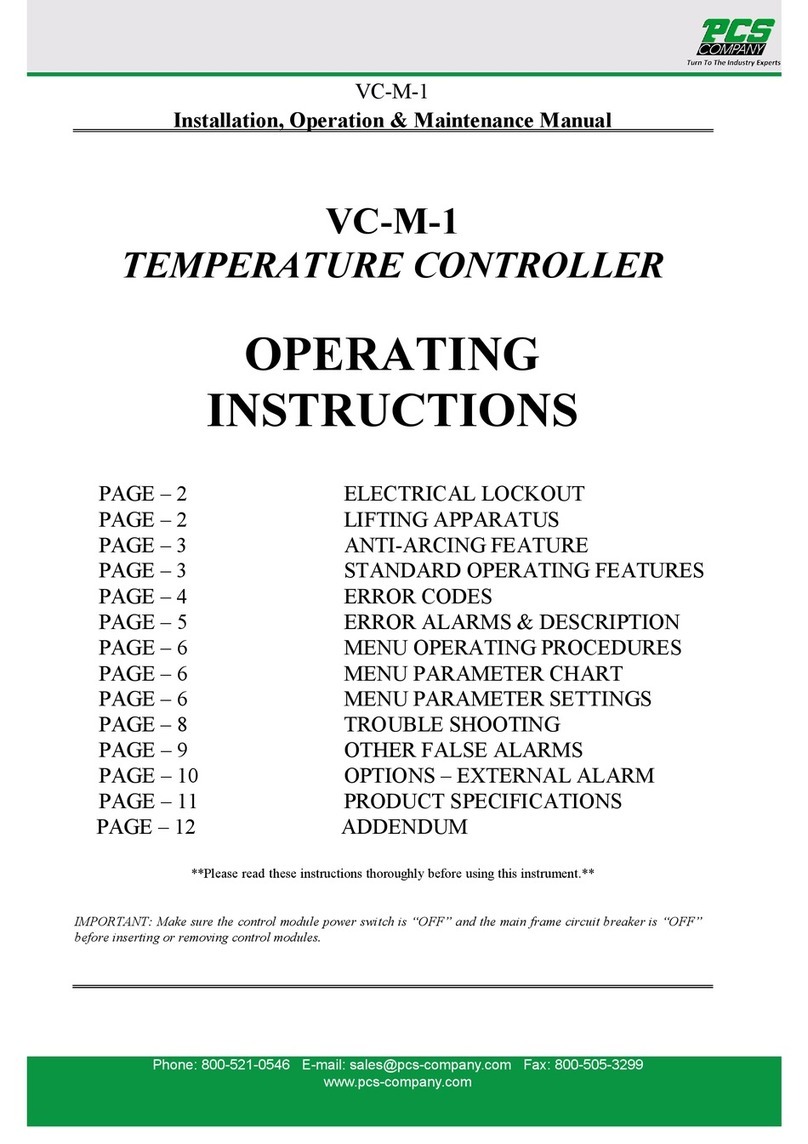
PCS
PCS VC-M-1 Installation, operation & maintenance manual
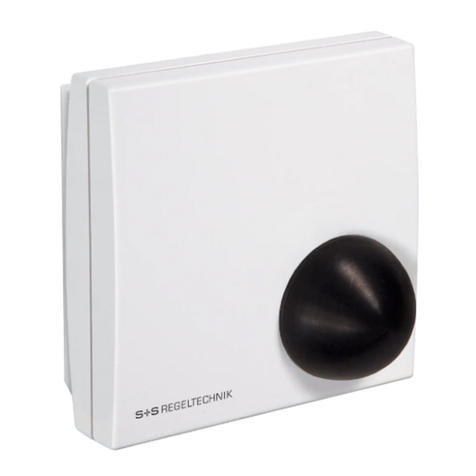
S+S Regeltechnik
S+S Regeltechnik THERMASGARD RSTF Operating Instructions, Mounting & Installation
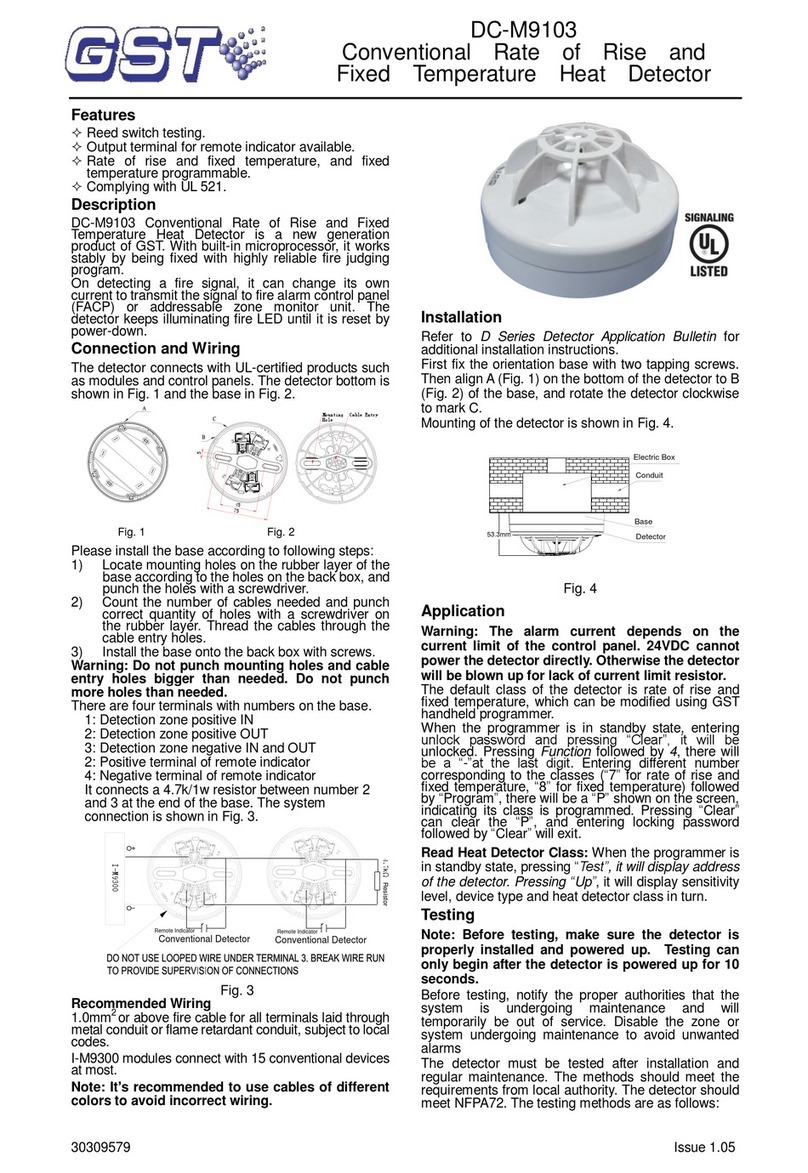
GST
GST DC-M9103 user manual
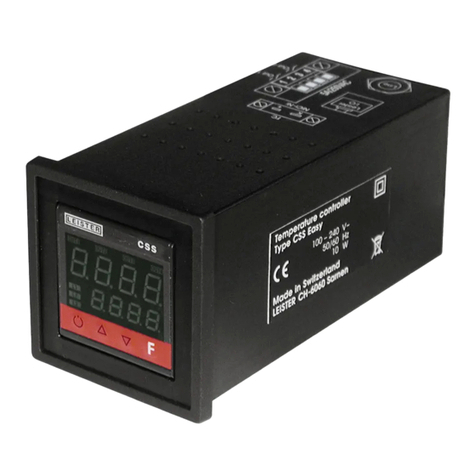
Leister
Leister CSS operating instructions
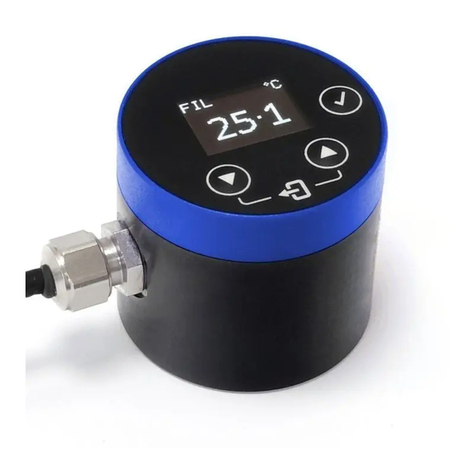
Calex
Calex PyroSigma Series Operator's guide

Lake Shore Cryotronics
Lake Shore Cryotronics Cernox CX-10XX-BO Instruction
